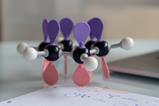We often write about ‘rewriting the textbooks’ in Chemistry World – it’s a well-worn trope of science news stories. We use it so often because it is so often useful – it shows how science continues to build and how our understanding changes as our knowledge improves. And it’s as true for the history of science as it is for science itself.
Our feature on June Sutor details how her work in the 1960s uncovered crystallographic evidence for C–H⋯O hydrogen bonds. The idea that hydrogen atoms bonded to carbon could behave this way was greeted with scepticism and Sutor’s proposal gained some influential opponents, which seldom bodes well for a new idea. To bastardise Arthur Eddington’s rule: if your theory contradicts a prominent scientist, I can give you no hope.
At the time, her hypothesis was also based on just a few x-ray structures, in which the position of the hydrogen atoms is hard to pinpoint, leaving the door open to doubt and making it hard to defend the idea. But, as further generations of crystallographers solved more and more structures, the evidence mounted and eventually Sutor was vindicated.
It’s impossible to say whether Sutor’s idea was suppressed by its detractors or overlooked for want of sufficient evidence. That remains an open question, which is fine, because it doesn’t really matter. The important point is that once we have sufficient evidence, we have a duty to not only rewrite the textbooks but to update the history books to acknowledge the past and restore credit to those who deserve it.
Some textbooks are still waiting for this particular revision: as Scott Horowitz notes, you won’t find mention of these bonds in the US general chemistry curriculum, for example. But thanks in part to our feature on Sutor, she does now have a Wikipedia page – written by University College London physicist and Wikipedian of the year Jess Wade as part of her campaign to improve the representation in Wikipedia’s pages.
And it needs to improve: as our story on Wikipedia’s disappearing women reports, the notability criteria used by the gatekeepers of the world’s largest encyclopaedia do seem to disadvantage women, and particularly women scientists. This is partly because women are often absent from the records Wikipedians rely on and is a symptom of the gender imbalance in science more generally; Wikipedia is inheriting our biases and perpetuating the injustice of exclusion. And the disparity is self-sustaining – it takes efforts like Wade’s to change the balance.
It’s important to make these efforts; to reflect the culture we want to have in the way we curate our history. In July, the Bank of England announced that Alan Turing will appear on the new £50 banknotes. Turing is a worthy recipient – for his contributions to science and the war effort but also because he was shamefully mistreated for being a gay man at a time when his sexuality was a criminal offence. Giving the honour to Turing makes an important statement about how society has changed and how we view our history. Though it could be regarded as a somewhat arch statement given that former chief executive of Standard Chartered bank Peter Sands has called the £50 note ‘the currency of corrupt elites, crime and tax evasion’ – it seems the notes bearing Turing’s likeness may also end up staying underground, hidden from society.
Rewriting the textbooks is our duty, because credit and recognition are much more than a reward for the individual. We use them to show what we value, and what matters to us – what lies behind us to be discovered is just as important as what lies ahead.

















No comments yet